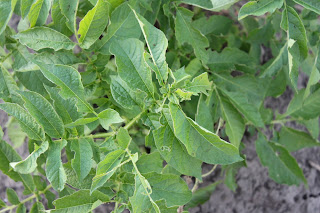Over the past few weeks everything excluding the carrots and turnips have been harvested and removed from the garden. Unfortunately a lot of it is literally just lying around the house while we keep our fingers crossed that it will ripen. At the moment there are spaghetti squash in the living room in front of the windows and green tomatoes covering a table and the floor in the basement while others are hanging in the cold room.
The spaghetti squash needs sun and warmth to ripen which is why it has taken up residence in our living room; I am glad to report it is slowly turning yellow. (That’s a good sign.) There hasn’t been much change in the tomatoes but there are a few that are starting to turn red. (We might get some after all!)
We do have one lonely zucchini plant in the garden that is living under a permanent cover of burlap. When I picked the last of the zucchini two weeks ago I left one plant as it was just starting to form a few zucchini and I was curious to see if they would develop. The last time I looked they were still growing, slowly, and more leaves and buds seem to be growing as well.
The beets, both red and yellow, have be picked and pickled, the onions and garlic and drying in the cold room, the last of the swiss chard has been blanched and frozen, and the potatoes are drying in the wheel barrel in the garage. The turnips (what doesn’t have worms) should be cleaned and blanched within a few days, and the carrots will probably be staying in the garden until Thanksgiving weekend.
I have an assortment of shorter blogs started regarding specific vegetables so be prepared to see and handful of new entries posted later this week. (hopefully)
Standing in the garden this afternoon seeing it so empty was both exciting and sad. After a long summer of gardening it’s exhilarating to pull the plants knowing you don’t have to worry about them anymore; it gives you the freedom to move on to other things. At the same time it’s sad because, well, it is done.
 |
| Not much left, 'tators are gone now too... |
It’s kinda ironic but as one garden winds down, the next is already being planned. While standing in the near empty garden this afternoon, and on a few other occasions, we’ve already had discussions of what to plant next year and how to do things differently.

































